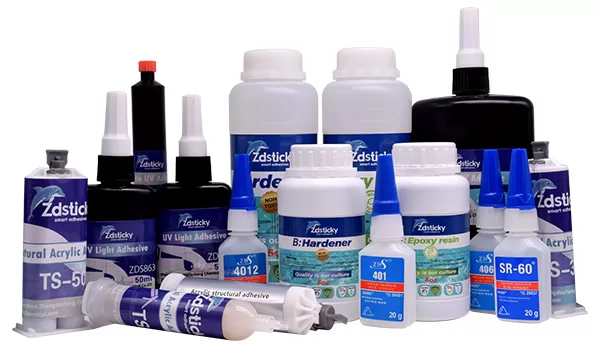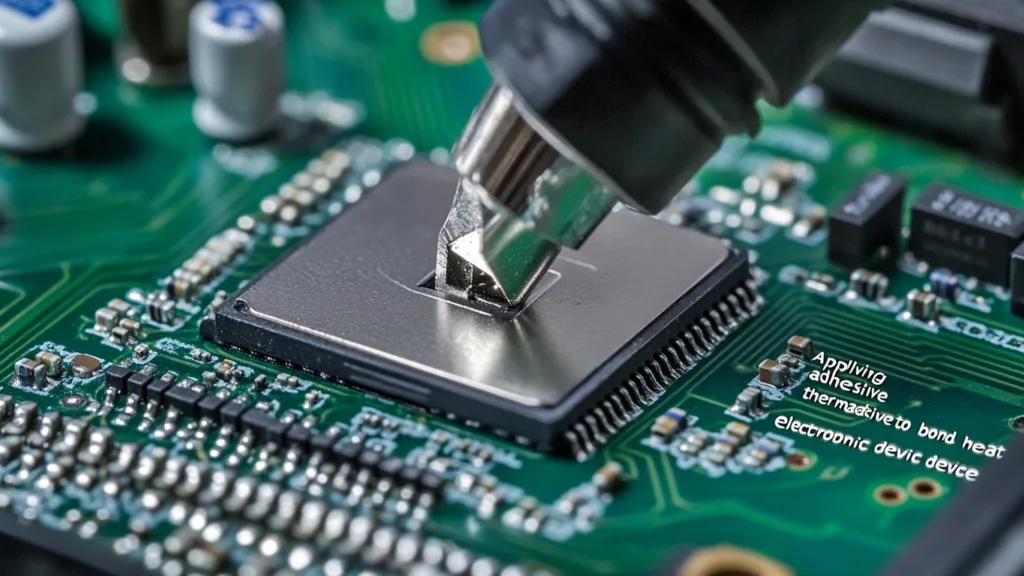In today’s fast world, keeping electronics safe is key. Electrical potting is a top way to do this. It wraps sensitive parts in strong, protective materials. This guide will cover all you need to know about electrical potting.
It will start with what it is and why it matters. We’ll talk about picking the best materials like epoxy and silicone. You’ll learn how to choose the right glue for your devices to last longer and work better.
If you work with electronics, knowing about potting electronics is vital. This guide aims to give you the knowledge and tips you need. Let’s explore electrical potting and find out how to protect your projects.
Key Takeaways
- Electrical potting encapsulates sensitive electronic components to protect against damage.
- Understanding different potting compounds like epoxy resins and silicone is crucial.
- Choosing the right potting adhesive and potting glue ensures optimal performance.
- Potting electronics can extend the lifespan and functionality of your devices.
- This guide helps you make informed decisions on materials and techniques.
Introduction
Electrical potting is key in making and fixing electronic devices. It uses a special compound to protect sensitive parts. This makes devices work better and last longer.
Potting means filling a space with a protective material, like epoxy or silicone. It keeps electronics safe from moisture, dust, and damage. Knowing about potting helps make devices last longer and work better.
The potting process involves pouring a liquid compound over parts. Then, it hardens to create a strong shield. This is crucial for devices used in tough places to keep them running well.
Choosing the right potting compound helps manage heat in devices. This stops overheating and failures. Solutions like ZDS™ meet specific needs, showing the importance of the right compound.
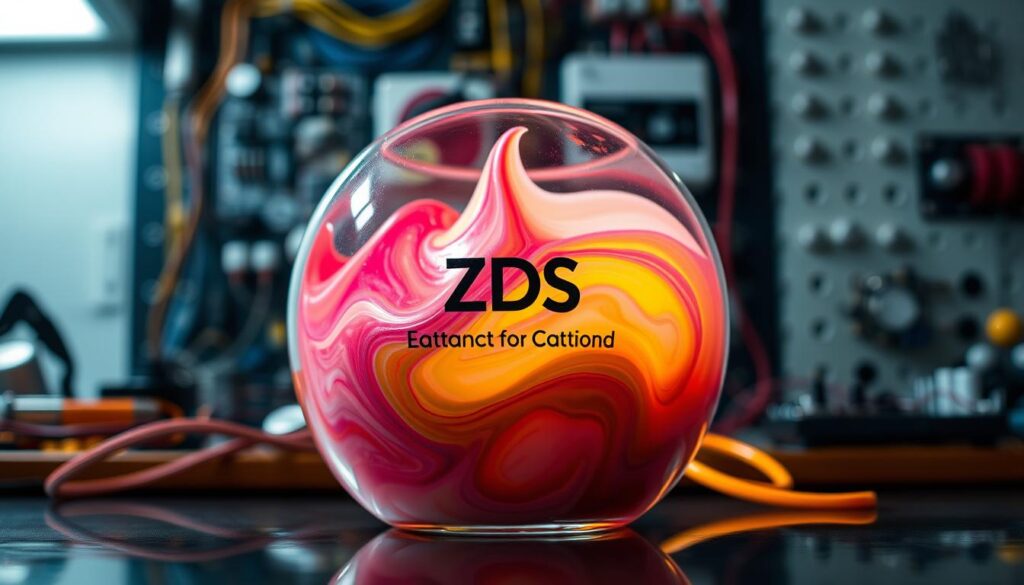
This introduction prepares us for learning more about potting compounds in electronics. It shows why this method is vital for those in the field.
Understanding Electrical Potting (what is potting)
Electrical potting is key in the electronics world. It makes electronic parts more reliable and perform better. By using a potting material, we shield these parts from harm.
This method keeps circuits safe from moisture, dust, and chemicals. It also helps in cooling down parts, which is crucial for their proper working. Plus, it gives parts the strength they need, stopping them from getting damaged by shakes or stress.
Knowing about potting materials is important. Polyurethane, for example, is very flexible and good at handling heat. This makes it a top pick. Looking into different types of potting materials shows how they meet various needs in tough settings.
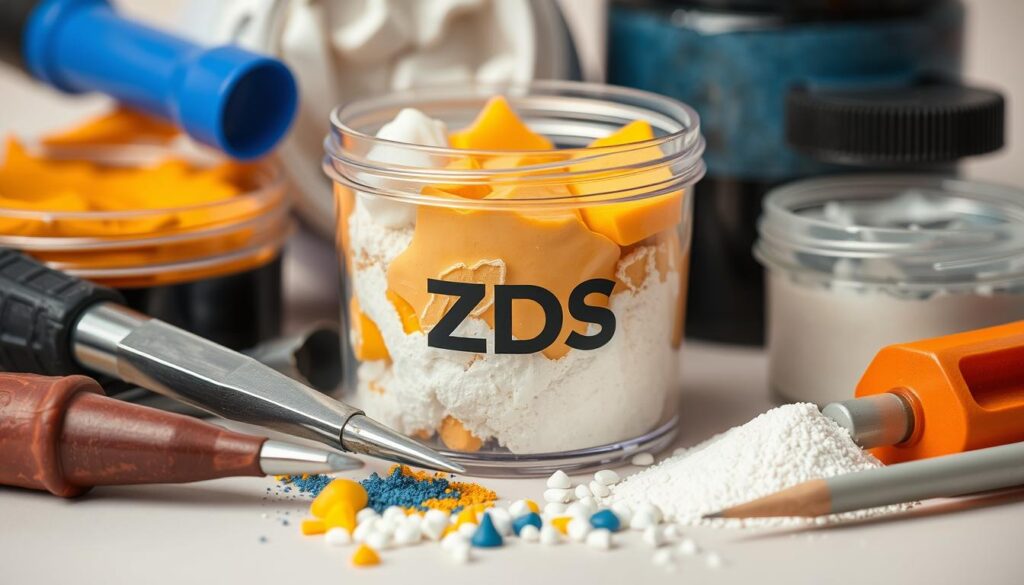
ZDS™ is known for its high-quality polyurethane products. They offer a wide range of products for different uses. This ensures that every potted circuit board gets the best protection and performance.
Types of Potting Compounds
Potting compounds protect electronic parts from moisture, dust, and chemicals. Choosing the right one is key for your devices’ performance and life. We’ll look at the main types, their features, and benefits.
Epoxy Resin Potting Compound
The epoxy resin potting compound is known for its strength and resistance to chemicals and heat. It creates a hard, protective layer around components. It also bonds well, making it great for strong adhesion needs. For a guide on using resin, check out this tutorial on making UV cured resin.
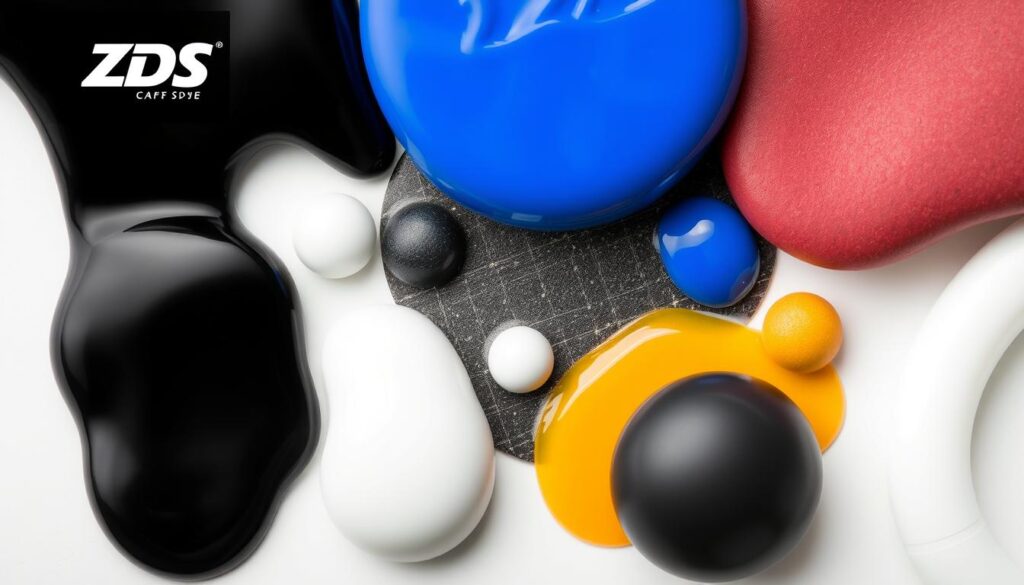
Silicone Potting Compound for Electronics
The silicone potting compound for electronics is flexible and resists high temperatures. It stays soft after curing, ideal for thermal changes. It also insulates well, perfect for electronic circuits. For more on resin ingredients, see this guide on UV resin ingredients.
Other Electronic Potting Compounds
There are many potting epoxy compounds beyond epoxy and silicone. Polyurethane compounds are less stiff but better for weight and flexibility. Urethane compounds resist moisture and chemicals well, great for tough environments. Each has its own strengths, meeting different electronic needs.
Choosing the Right Potting Material for Electronics
Choosing the right potting material for electronics is crucial. It depends on the device’s needs and how it works. We’ll look at what matters most in making this choice.
Thermal conductivity is key when picking an electronic potting compound. Good heat dissipation prevents overheating and keeps components working longer. Polyurethane resins with high thermal conductivity are great for high-power devices.
Another important factor is electrical insulation properties. The potting material must protect sensitive parts from electrical issues. This is vital for devices with many components.
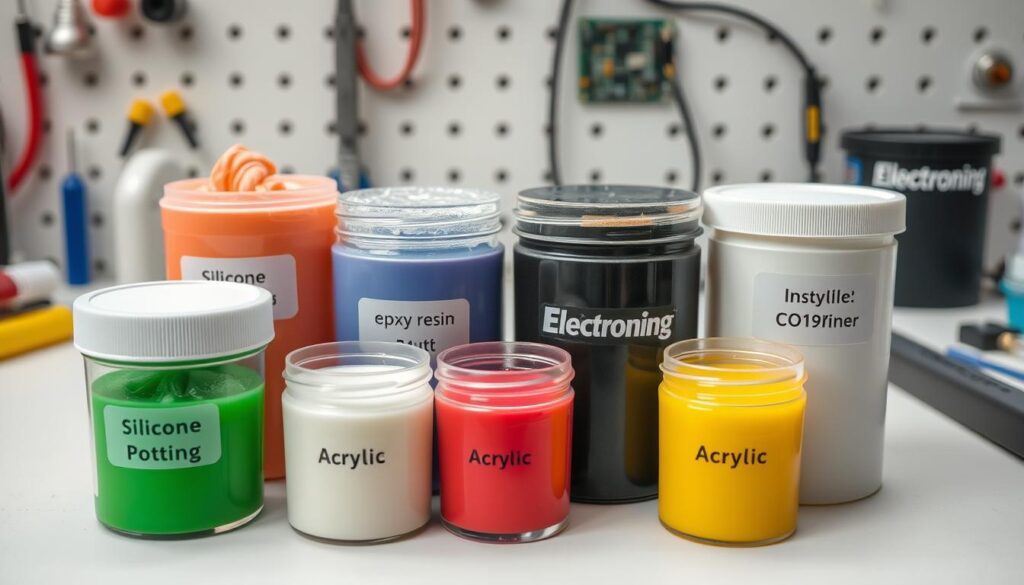
Hardness and chemical resistance are also crucial. The material must handle mechanical stress and harsh environments. For example, car parts need compounds that can handle vibrations and chemicals. Polyurethane resins from ZDS™ are known for their strength and performance.
Getting help from experts like ZDS™ can be very helpful. They focus on innovation and eco-friendly practices. Their wide range of products is perfect for electronics needing special potting solutions.
Choosing the right electronic potting compound is about finding a balance. By understanding the device’s needs and using the best materials, we can improve its reliability and performance.
The Potting Process
The potting process is key to making electronic parts last longer. First, we clean each part well to remove dust or dirt. This makes sure the potting resin bonds evenly.
Then, we mix the potting material carefully. We measure everything right and mix it well. Epoxy resin is often used because it sticks well.
When we apply the potting compound, spreading it evenly is important. We pour it slowly to avoid air bubbles. Using a degassing chamber helps remove air before it sets.
The curing stage is also crucial. The time and conditions needed vary based on the material. For example, epoxy resin might need specific heat to harden right.
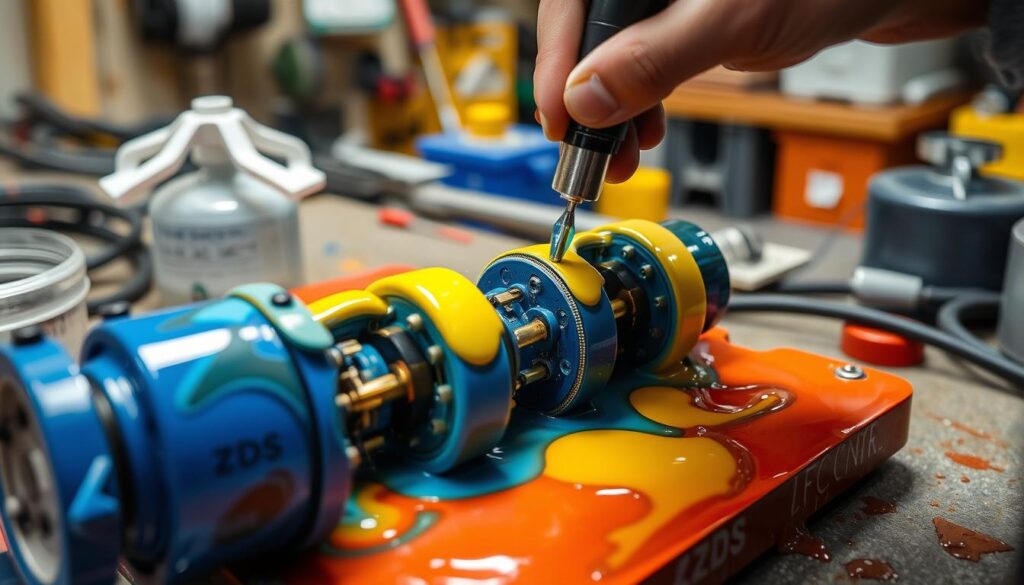
- Preparation: Clean components to remove contaminants.
- Mix Potting Material: Measure and mix thoroughly.
- Application: Pour the potting resin evenly, avoiding air entrapment.
- Curing: Follow specified curing times and conditions.
Following these steps helps protect electronic parts. For more on choosing the right materials and methods, check out ZDSchemical’s guide on metal bonding.
Applications of Potting in Electronics
In the fast-growing electronics world, potting plays a key role in keeping components safe. It involves covering parts in a protective layer to guard against moisture, shock, and heat. This method is crucial in many fields, like cars, planes, gadgets, and medical tools.
One big use is in protecting potted circuit boards. By using materials like epoxy or silicone, makers keep circuits safe from shakes and harsh weather. This is especially true for car parts, like ECUs, which face tough conditions.
In the aerospace field, where safety and performance are top priorities, potting is essential. It keeps avionics and other vital systems safe, ensuring they work well even in extreme conditions.
Smartphones and tablets also benefit from potting. It helps keep their insides safe from heat and moisture, making them more reliable. The right potting material stops damage from daily use and the environment.
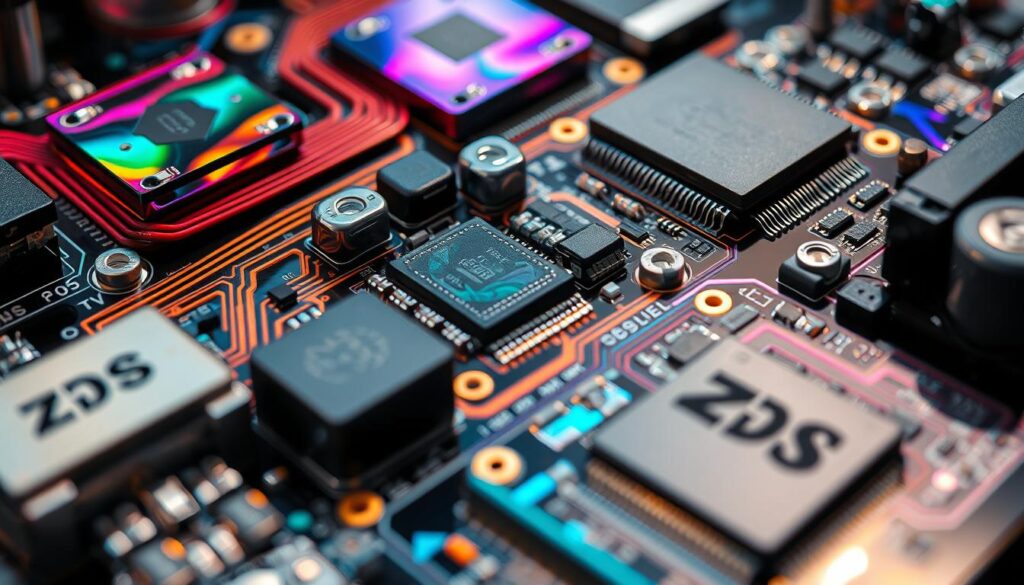
Medical devices also use potting to protect their complex electronics. Things like pacemakers and insulin pumps need to be very safe and reliable. High-quality potting materials help keep these devices working right, keeping patients safe.
| Sector | Example | Benefits |
|---|---|---|
| Automotive | Electronic Control Units (ECUs) | Protects against vibrations and extreme temperatures |
| Aerospace | Avionics | Ensures reliability in high-altitude conditions |
| Consumer Electronics | Smartphones | Prevents overheating and moisture damage |
| Medical Devices | Pacemakers | Maintains component integrity for patient safety |
Potting is vital in many fields for keeping electronics safe and working well. It helps gadgets and devices perform well in tough settings. The use of potting is growing, ensuring electronics are reliable and efficient in many environments.
Benefits of Using Potting Compounds (potting compound, potting resin)
Electrical potting offers many benefits for electronic devices. It adds a strong layer of protection against moisture, dust, and chemicals. This is key in keeping devices running smoothly.
It also helps dampen vibrations. This is very useful in places where equipment moves a lot and gets shocks.
Using potting adhesive can save a lot of money. It makes devices last longer and need less fixing. This means less work and lower costs for makers.
It also helps keep devices cool. This stops them from overheating and makes them last longer.
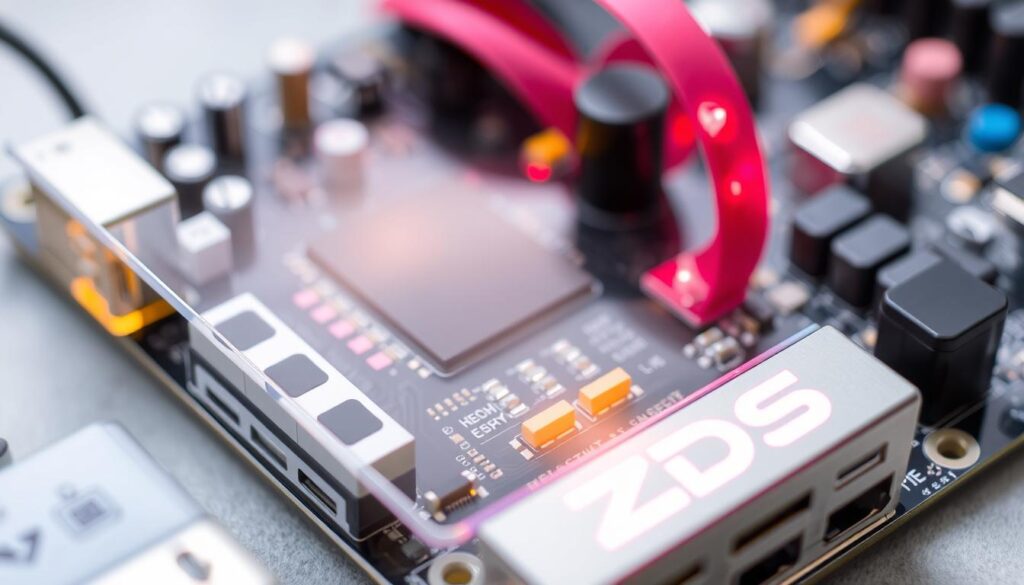
Using potting resin keeps devices working well, even in tough conditions. It also stops short circuits and electrical failures. This makes devices safer to use.
To find the best adhesive for your needs, check out the adhesives selection guide.
| Benefits | Advantages |
|---|---|
| Vibration Damping | Reduces wear and tear on components |
| Heat Dissipation | Prevents overheating and extends service life |
| Environmental Protection | Shields against moisture, dust, and chemicals |
| Cost Savings | Lowers maintenance and reduces failure rates |
Advanced Potting Techniques and Innovations
The field of electrical potting is always changing. To stay ahead, we must use the newest techniques and innovations. These changes make the potting process better, faster, and more eco-friendly.
Eco-friendly potting compounds are a big step forward. New materials have led to safer, better-performing products. For example, ZDS™ offers top-notch composite epoxy resin. It meets high standards, as seen in their marine epoxy resin.
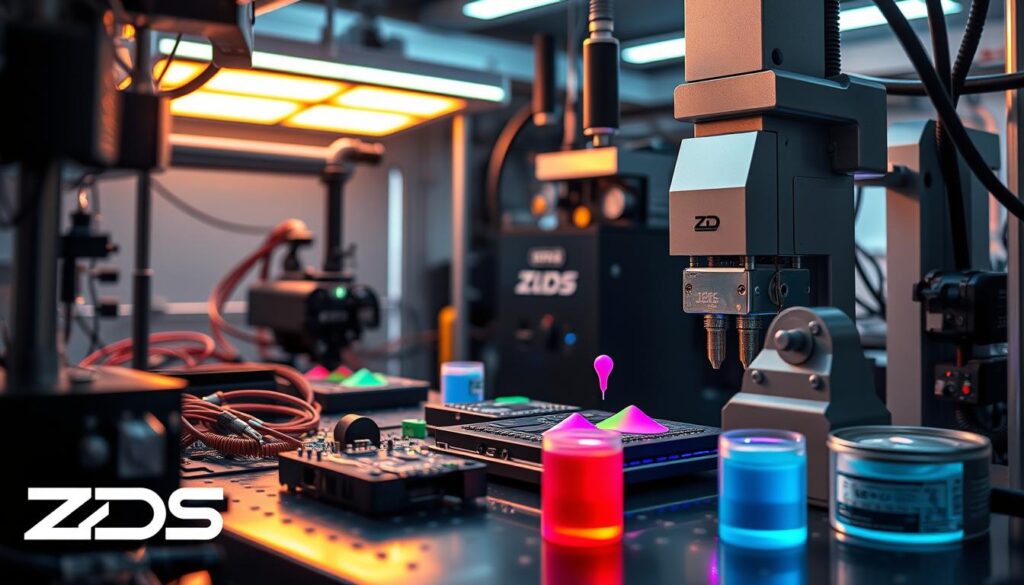
Automation is also making a big impact. It brings precision and consistency, cutting down on mistakes. This is especially helpful for big projects where speed and volume matter.
Advances in sensors are changing how we watch and control the potting process. Now, sensors can quickly spot and adjust to changes. This means better, more reliable potting results.
There’s also a move towards potting compounds that do it all. These materials handle thermal management, electrical insulation, and support all at once. This makes the process simpler, saves materials, and can cut costs.
For those wanting to dive into these new options, ZDS™ is a great place to start. They have a wide range of advanced potting solutions for different needs. By keeping up with these advancements, we can get the best results in our work.
Conclusion
In wrapping up our ultimate guide to electrical potting, we highlight its key role. It boosts the reliability and life of electronic devices. Knowing the differences between potting epoxy compounds and silicone potting compound for electronics is crucial. It helps in making choices that fit specific needs.
We’ve covered many aspects of potting in this guide. We explained what electronic potting compounds are and looked at different types like epoxy resin and silicone. We also talked about the importance of picking the right material.
Discussing the potting process in detail, we also touched on advanced techniques and innovations. These are changing the field of potting.
Now, think about how this info can help you with your projects. Whether you’re a hobbyist or a business looking to make products last longer, we aim to help. Our goal is to give you the knowledge to use electronic potting compound solutions well.
FAQ
What is potting in electronics?
Potting in electronics means covering parts with a protective material. This material, like epoxy resin or silicone, keeps parts safe from damage. It makes the parts work better and last longer.
What are the benefits of using an epoxy resin potting compound?
Epoxy resin compounds are strong and stick well. They also resist chemicals and extreme temperatures. This makes them perfect for tough environments.
How do I choose the right potting material for my electronics?
Choosing the right material depends on several things. You need to think about how well it conducts heat, insulates, and resists chemicals. It should match the needs of your electronic parts.
What is the potting process?
The potting process starts with getting the parts ready. Then, you apply the material and let it dry. You clean the parts, mix the compound, and pour it in. Make sure there’s no air trapped. After that, it dries to protect the parts.
What are the different types of electronic potting compounds?
There are many types, like epoxy, silicone, and polyurethane. Epoxy is strong and resistant to chemicals. Silicone is flexible and good for high temperatures. Polyurethane balances mechanical and electrical properties.
Why is electrical potting important for circuit boards?
Potting protects circuit boards from harm. It keeps them safe from moisture, dust, and extreme temperatures. This ensures they work well for a long time.
What are some applications of potting in electronics?
Potting is used in many fields. It’s in cars, planes, gadgets, and medical tools. It keeps PCBs, sensors, and connectors safe from damage.
What innovations are shaping the future of potting compounds?
New materials and methods are coming. They improve how well potting compounds work. This includes better heat handling and being kinder to the environment. New ways of applying the compounds make the process smoother.
Can silicone potting compound be used for high-temperature electronics?
Yes, silicone is great for hot electronics. It stays stable and flexible even in extreme heat. It’s perfect for keeping parts safe in very hot conditions.
What are the benefits of using potting adhesives?
Potting adhesives make electronic parts stronger. They keep parts together and protect them from shock and damage. This helps devices work better and last longer.






